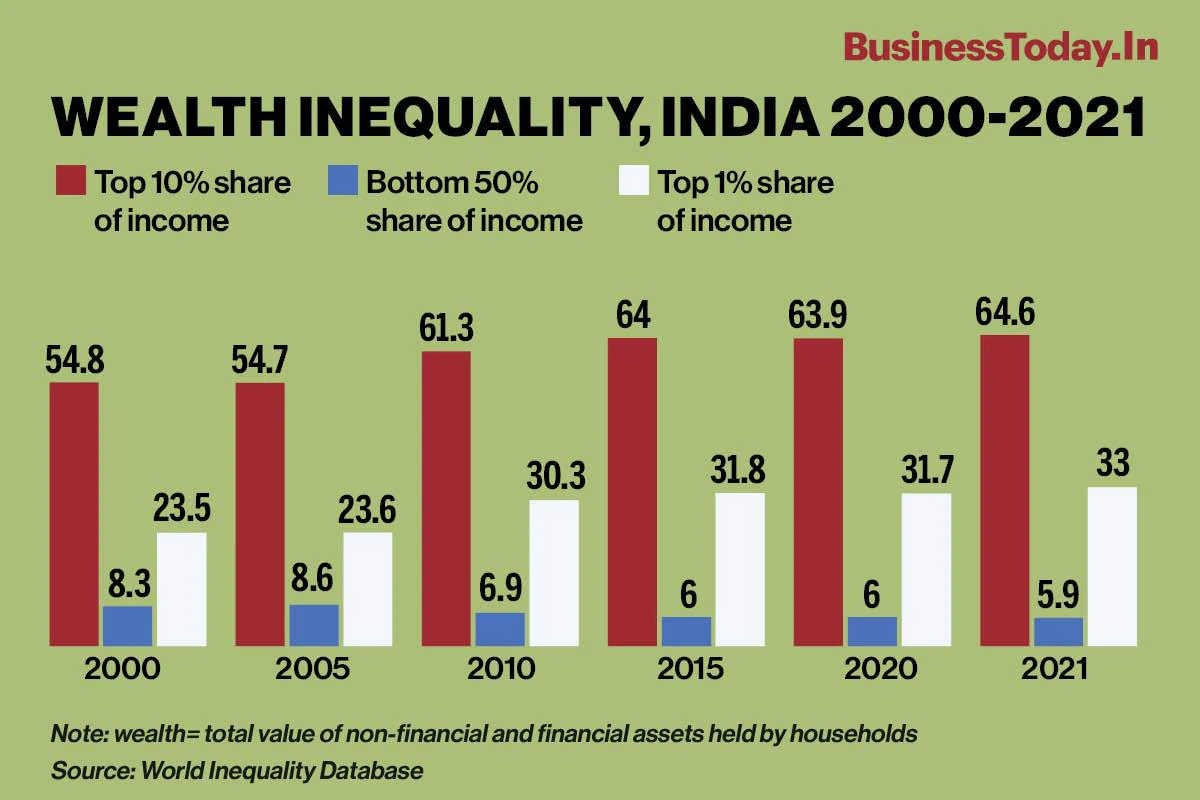-
31 Jul 2024
GS Paper 2
Social Justice
Day 21: In a country like India, where wealth is concentrated in the hands of a few, poverty is a challenge we cannot ignore. Discuss (250 words)
Approach
- Briefly introduce the concept of poverty as a menace in India.
- Highlight the interconnection between inequality and poverty.
- Suggest measures for addressing the interconnected issues of inequality and poverty.
- Conclude Suitably.
Introduction
According to the World Bank, poverty is defined as "pronounced deprivation in well-being," focusing on individuals' capabilities to function in society. Poor individuals often experience inadequate income, education, health, and political freedoms. The World Bank designates extreme poverty as living on less than $2.15 per person per day.
Concentration of wealth refers to the unequal distribution of assets and resources within a society, where a small percentage of the population holds a significant portion of total wealth. India is one of the most unequal countries in the world, with the top 10% of the population holding 77% of the total national wealth.
Body
The interconnection between the concentration of wealth and poverty:
- Unequal Wealth Distribution: Inequality in wealth distribution leads to a concentration of resources in the hands of a few, leaving a significant portion of the population without access to basic needs. This disparity contributes to poverty, as those at the bottom of the economic ladder struggle to improve their living conditions.
- According to the World Inequality Report 2022, India is among the most unequal countries in the world, with the top 10% and top 1% of the population holding 57% and 22% of the total national income respectively. The share of the bottom 50% has gone down to 13%.
- Lack of Access to Opportunities: Inequality restricts access to education, healthcare, and employment opportunities for marginalized groups. When certain populations are systematically excluded from these essential services, their ability to escape poverty diminishes, perpetuating the cycle of disadvantage.
- As per Census 2011, literacy rate of Scheduled Tribes (STs) was 59% whereas the overall literacy rate was 73% at all India level.
- Limited Social Mobility: High levels of inequality often result in low social mobility, where individuals from poorer backgrounds find it challenging to improve their socio-economic status. This lack of upward mobility reinforces poverty, as families remain trapped in a cycle of disadvantage across generations.
- In India, it would take 7 generations for a member of a poor family to achieve average income, according to the World Economic Forum's Global Social Mobility report.
- Lead to Political Inequality: Economic inequality can lead to political inequality, where wealthier individuals or groups have more influence over policy-making. This often results in policies that favor the affluent, further marginalizing low-income populations and limiting their opportunities for advancement.
- About 504 or 93 % of the 543 MPs elected to the 18th Lok Sabha are crorepatis
- Health Disparities: Inequality contributes to health disparities, as poorer individuals may lack access to quality healthcare and nutritious food. Poor health can hinder one's ability to work and earn a living, exacerbating poverty and limiting economic potential.
- Around 74% of India’s population could not afford a healthy diet, and 39% fell short of a nutrient-adequate one.
- Cycle of Poverty: The relationship between inequality and poverty is cyclical; poverty can lead to inequality as well.
- A World Bank study found that out of 7 crore people globally who became poor that year due to economic losses caused by the pandemic, Indians accounted for 5.6 crore.
Measures for Addressing the Interconnected Issues of Inequality and Poverty
- Foster Inclusive Framework:
- Enforce Constitutional Provision: Enforce constitutional guarantee of equality as enshrined in fundamental rights through policy measures. Government policies that are formulated to strengthen these rights need strict implementation.
- Progressive Taxation: Implementing progressive taxation in India can help reduce income inequality by ensuring that those who earn more contribute a higher proportion of their income to taxes.
- Inclusive Governance: Foster inclusive governance by encouraging citizen participation, promoting transparency, and reducing corruption. Empower local self-governments and involve marginalized communities in decision-making processes.
- Private Sector Engagement: Encourage corporate social responsibility (CSR) initiatives that focus on inclusive development. Encourage private companies to invest in social sectors and support community development projects.
- Increase the Reach of Basic Necessities:
- Universal Access to Public Services: By ensuring universal access to public funded high-quality services like public health and education, social security benefits, employment guarantee schemes, inequality can be reduced to a great extent.
- Employment Generation: The labor-intensive manufacturing sector of India has the potential to absorb millions of people who are leaving farming while the service sector tends to benefit the urban middle class.
- Women Empowerment: Promote gender equality in education, employment, and entrepreneurship to empower women economically and socially.
- Social and Financial Inclusion:
- Land Reforms: Implement land reforms to address issues of land ownership and tenancy. Ensure fair and equitable distribution of land resources.
- Promoting Civil Society: Provide a greater voice to traditionally oppressed and suppressed groups, including by enabling civil society groups like unions and associations within these groups.
- Technology and Innovation: Embrace technological advancements to create new opportunities for all.
- Ensure that the benefits of technological progress are shared across different sections of society.
Conclusion
Nobel laureate economist Amartya Sen emphasizes the need to address social inequalities and invest in education and healthcare to combat poverty in India and promote sustainable economic development. By embracing and implementing inclusive policies that tackle the underlying causes of inequality, India has the potential to transition towards a more equitable society. This transformative approach aligns with the aspirations of the United Nations' Sustainable Development Goal 10.






